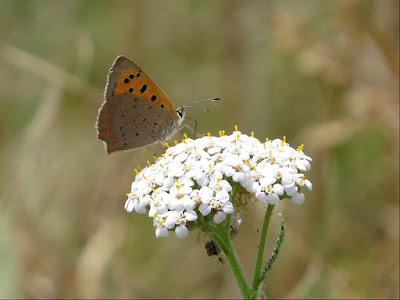It was a sunny warm day on the Common and I decided to undertake a walk around the lower terrace and along the terrace bank, taking in the heather covered areas that were now in bloom.
Large numbers of Heather Colletes were present feeding on the Ling heather flowers. Also recorded were 7 Beewolf (2♂, 5♀). A Brown-banded Carder Bee was observed feeding on the Musk Thistle flowers.
♀ Beewolf (Philanthus triangulum)
Brown-banded Carder Bee (Bombus humilis)
Despite the fine weather conditions there wasn't that much in the way of butterfly activity, with 5 Small Copper being the exception. I also recorded a new micro-moth for my site year list in the form of Pearl Grass-veneer.
Thursday 10th August 2017:
For today's visit I undertook a walk on the lower heath side of the Common and the crossed over the Worcester Road to continue around the lower terrace area. At the lower heath 1 Brown Argus, 2♂ Common Blue and a Small Copper were noted.
♂ Brown Argus (Aricia agestis)
Also of interest during the walk were a small number of Ramshorn Galls that I discovered on one of the Oak trees. These galls are caused by the gall wasp Andricus aries.
Ramshorn Gall (Andricus aries)
Whilst at the lower heath I decided to use my sweep net and sweep through the area of Lady's Bedstraw near the entrance by Cooks. This proved a worthwhile exercise as I swept 5 Sermylassa halensis flea beetles. A species that has a preference for Bedstraw as it's main food plant for both adults and larvae.
Sermylassa halensis
Also of note at Lower Heath was a single Common Lizard that was seen scurrying off into the heather and a rather stunning area of Toadflax that was now in bloom on the western edge of the site.
Toadflax (Linaria vulgaris)
From the lower heath I headed across the Worcester Road to the lower terrace. Here 2 immature Migrant Hawker dragonflies were of observed. This is the first time I have recorded this late summer/autumn species at the site this year. Also of note on in this area of common was a single female Pantaloon Bee that was feeding on the Musk Thistle flowers.
Migrant Hawker (Aeshna mixta)
Pantaloon Bee (Dasypoda hirtipes)














































